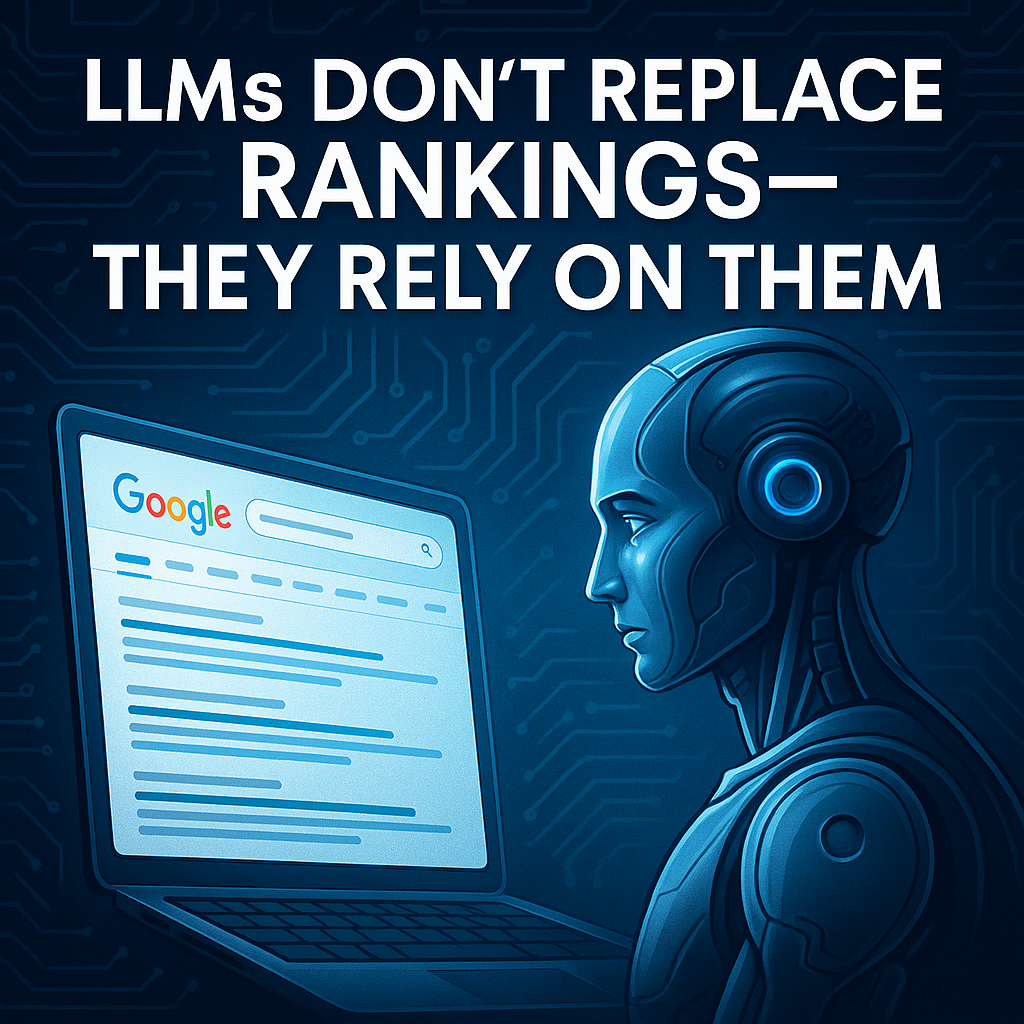LLMs Don’t Replace Rankings – They Rely on Them

Everyone’s talking about how AI is changing search, but what most people haven’t clocked is that GPT doesn’t replace traditional search infrastructure – it relies on it.
That has huge implications for how we think about SEO, visibility, and the durability of existing systems.
Why GPT’s Use of Search Engines Reinforces – Not Replaces – SEO Fundamentals
There’s a common misconception that LLMs like GPT are replacing search.
In reality, they are leaning on it.
When you ask GPT a high-intent question – for example, “best CRM for law firms” or “top-rated debt recovery solicitors” – it does not draw from some universal AI truth. It runs your prompt through a retrieval pipeline, usually Bing and possibly now Google, scrapes a few top results, and generates a response based on what it finds.
This means traditional search visibility – the kind we have spent decades optimising for – is now a critical input into how generative systems respond.
That is not a shift. It is a spotlight.
It highlights how robust the authority-based model still is. The industry largely misunderstood what AI would displace, but GPT’s reliance on existing search infrastructure proves that the foundations of SEO remain intact.
LLMs have not replaced the system. They are revealing just how dependent they are on it.
SEO – real SEO – is more insulated than people realise. Visibility still hinges on authority. Rankings still determine what gets surfaced. Machines are now the ones making first impressions on your behalf.
🔍 GPT Performs a Search – Then Scrapes
Let’s break it down.
When you ask GPT-4 with browsing to “find the best CRM for a small law firm,” it doesn’t pull from some proprietary OpenAI index.
It reformulates your prompt into a search query, sends it to Bing’s API, and receives a small set of top-ranked results – usually around ten. These are ranked by Bing using the same fundamentals as any other search engine: query intent, content relevance, and authority.

GPT then filters this shortlist using basic relevance signals like title, freshness, and domain trust. From there, it crawls a handful of those pages in real time, pulls structured data (like JSON-LD), and assembles a response.
This isn’t some new paradigm of AI-native search.
It’s a duct-taped retrieval layer piggybacking on Bing – the same Bing that’s barely cracked 10% market share in two decades.
So if your site doesn’t appear in Bing’s index? You’re invisible to GPT browsing.
If your page lacks authority? You never make the shortlist.
If your title and meta are weak? You get skipped.
If the page that does get crawled is bloated, confusing, or outdated? GPT won’t pull from it.
Visibility still matters – because GPT can’t use what it doesn’t see.
🤖 Search Visibility Itself Has Become a Ranking Factor
When I first coined the term Machine Experience, it was out of necessity. Clients would bring me sites they had just launched and ask me to “do SEO” – only for me to explain that the entire structure needed rethinking. Their UX teams had focused on user flows and ignored authority distribution. Fixing it meant revisiting design decisions they thought were done and dusted.
So I started reframing the problem. Not as SEO. Not as UX. As Machine Experience – the experience machines have of your website. Crawlers. Parsers. Algorithms. Systems that don’t browse – they extract, crawl, and rank.
At first, that meant Google’s PageRank – the authority distribution system that determines which pages get surfaced.
Then RankBrain added another layer: engagement signals. Bounce rates, dwell time, click-through rates. MX needed to reflect not just what got crawled, but what got rewarded based on user interaction.
When generative AI entered the scene, I assumed we were entering a new frontier. A third layer. Something novel.
Early indications suggested this would be heavily reliant on schema markup and structured data – a machine-readable web optimised for LLMs. That seemed to be the new battleground.
However what we’ve learned is that GPT isn’t sidestepping search – it’s built on top of it. The machine experience that governs what GPT sees is largely the same one we’ve been optimising for all along.
It still comes down to whether you’re visible in Bing or Google:
- Whether your content makes the shortlist.
- Whether your page carries authority.
In other words: LLMs aren’t redefining machine experience – they’re inheriting it.
Visibility in search now determines what these systems even see.
- If you don’t rank, you don’t get surfaced.
- If you don’t get surfaced, you don’t exist.
Search rankings are no longer just for users – they’ve become the input layer for AI.
🎯 What This Means for MX Strategy
If you’ve been following my work on Machine Experience and MX Engines, you already know where this is going.
Your internal linking, your crawl paths, your structured data – these don’t just influence how Google sees your site. They influence how every machine sees your site.
From Bing’s API…
To GPT’s retrieval model…
To the AI summaries showing up on SGE, Perplexity, and God-knows-what next…
The entire stack is search-dependent. Which means visibility is the new infrastructure.
If your MX Engine isn’t tuned -if your SEO capital isn’t compounding on asset pages designed to convert – then you’re handing visibility (and AI exposure) to your competitors.
A Quick Note on Bing vs Google
Officially, GPT’s web results are pulled from Bing. OpenAI has a long-standing partnership with Microsoft, and the browsing tool within ChatGPT uses Bing’s API to generate its result list.
Throughout this article I’ve sometimes referred to GPT pulling results from Bing and/or Google. That’s based on some recent chatter – most notably from Alexis Rylko – suggesting that GPT may, in some instances, be pulling data from Google’s index.
This hasn’t been confirmed by OpenAI, but a few reverse-engineered prompts have shown search result patterns that align more closely with Google than Bing.
Either way, it doesn’t materially change anything.
The fundamentals remain the same.
What ranks in Google typically ranks in Bing.
And what’s visible to search engines is what gets surfaced by GPT.
If anything, it’s just further confirmation: search visibility is now the input layer for the machine web.
Final Word
Machine Experience used to be about influencing how search engines crawled, interpreted, and ranked your site.
Today, it goes further.
That same experience now determines what LLM systems see – and what they skip.
This isn’t about “optimising for AI.”
It’s about realising that real SEO already does.
The future belongs to those who treat authority as capital and allocate it with purpose.
This is what Sovereign SEO was built for.
Get in touch to see how a Sovereign SEO strategy can put your most important pages ahead of the competition.

Mike Simpson
With nearly 15 years of experience in SEO and digital marketing, Mike has built a reputation for driving growth and innovation. His journey began at Havas Media, where he developed expertise in client management, technical auditing, and strategic planning for top brands like Tesco Bank and Domino’s Pizza. He progressed to leading teams at Forward Internet Group and IPG Media-Brands, before taking on the role of Commercial Director & Chief Product Strategist at Barracuda Digital, where he delivered significant results for high-profile clients.
Now working as a consultant, Mike leverages his extensive experience to help businesses enhance their digital strategies, delivering bespoke solutions and measurable success. His strategic insights and dedication have made him a sought-after expert in the industry.